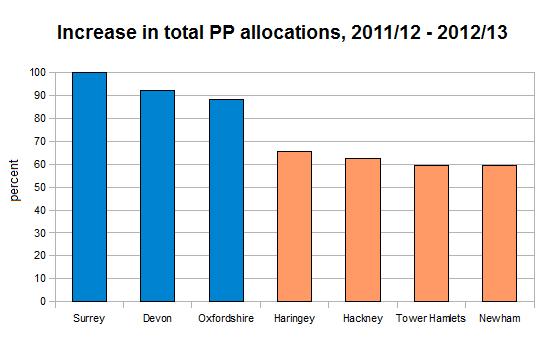Do less deprived areas get more money from the Pupil Premium?
David Lammy: "The Secretary of State and the whole House will recognise the deprivation in Newham, Tower Hamlets, Haringey and Hackney. Why, then, has the Secretary of State decided to give more money in his pupil premium to Oxfordshire, Surrey and Devon?"
Michael Gove: "We have not. The pupil premium goes to every child eligible for free school meals and is allocated precisely according to need."
House of Commons, 27 February 2012
David Lammy and Education Secretary Michael Gove clashed during Education questions yesterday when the former accused the latter of giving more Pupil Premium funding to less deprived areas than was being given to more deprived inner London boroughs.
Join 72,953 people who trust us to check the facts
Sign up to get weekly updates on politics, immigration, health and more.
Subscribe to weekly email newsletters from Full Fact for updates on politics, immigration, health and more. Our fact checks are free to read but not to produce, so you will also get occasional emails about fundraising and other ways you can help. You can unsubscribe at any time. For more information about how we use your data see our Privacy Policy.
The Pupil Premium was introduced following the Coalition Agreement, and provides schools with extra money allocated to pupils in receipt of free school meals.
Mr Lammy claimed that Newham, Tower Hamlets, Haringey and Hackney were getting less Pupil Premium money than Oxfordshire, Surrey and Devon. Mr Gove denied that this was the case.
So what are the facts behind the disagreement?
Analysis
The Department for Education provides data on allocations for the upcoming financial year 2012/2013 - allocations that, it stresses, are indicative and illustrative rather than necessarily a precise reflection on the final settlement.
Examining the data at local authority level shows the amount each is estimated to receive in the coming year. The table below covers the seven authorities mentioned by Mr Lammy:

The total eligible is the estimated number of pupils who have been or still are in receipt of Free School Meals (FSM) in the past six years. The Premium is then given in three different forms - based on 'Deprivation' (recipients of FSM), 'Service Child' (whose parents are in the armed forces) and 'Looked After' (in care continuously for more than six months).
Funding for each authority is derived from the number of eligible pupils, with £600 given per pupil in the 'Deprivation' or 'Looked After' categories and £250 given to Service Children.
The table shows that of the seven authorities mentioned by Mr Lammy, Tower Hamlets is likely to receive the most money next year, followed by Newham, Surrey, Devon, Haringey, Oxfordshire and finally Hackney.
On the face of it, these figures seem to lend more support to Michael Gove's understanding of the figures, and apparently disprove Mr Lammy's comments about more money being given to the less deprived areas.
So what does the Tottenham MP base his claim upon?
After contacting Mr Lammy's office, it was made clear that he had not in fact been referring to the total money going to each authority, but the change in allocations since 2011/12.
Fortunately, the Department for Education also provide the allocations from 2011/12. The figures for the same areas are shown below:

The allocations for this year tell a similar story to the upcoming year - namely that Tower Hamlets and Newham receive the most. But accounting for the increase between 2011/12 and 2012/13 sheds light on where Mr Lammy's claims came from.
The following chart demonstrates that, taking the overall allocations for each authority, the less deprived areas Mr Lammy cites have seen their allocations increase by the largest amount. As Mr Lammy's office told Full Fact, the story is similar considering the increase in the Deprivation category alone.

So why have these areas seen a larger increase?
The Government provide an information summary about the Pupil Premium allocations for 2012/13. This confirms that, since last year, the Government has widened the cohort of pupils eligible for the Premium.
While in 2011/12, the recipients in the 'Deprivation' category were those who received Free School Meals, in 2012/13 this was widened to include pupils who had received FSM at some point in the last six years. The extension was made following a consultation in which the six-year rule was the preferred option.
Along with an increase in the Deprivation allocation from £488 per pupil last year to the current £600, this sees around 555,000 more pupils eligible for the Premium. It is from this increase that Surrey, Devon and Oxfordshire have seen their relatively large increases.
The bias towards the less deprived areas could be for any number of reasons. One interpretation of the data would be that the more deprived areas have fewer pupils who have been on FSM in the past and since moved off. Conversely, the less deprived areas may have more pupils who have moved off FSM in the past six years.
Conclusion
Mr Lammy's statement yesterday is ambiguous. It would be wrong to conclude from his claim that the inner London boroughs are receiving less funding - this is not the case.
Instead, he is in fact referring to the funding increases as a result of the expansion of the Premium to 555,000 more pupils across the country. On this measure, the more well-off areas have indeed seen steeper rises.
The disagreement between Mr Lammy and the Education Secretary therefore boils down to a different interpretation of the figures.